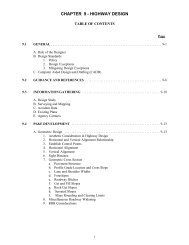Baltimore-Washington Parkway Widening Feasibility Study
Baltimore-Washington Parkway Widening Feasibility Study
Baltimore-Washington Parkway Widening Feasibility Study
- No tags were found...
You also want an ePaper? Increase the reach of your titles
YUMPU automatically turns print PDFs into web optimized ePapers that Google loves.
<strong>Baltimore</strong>-<strong>Washington</strong> <strong>Parkway</strong> <strong>Widening</strong> <strong>Feasibility</strong> <strong>Study</strong>Traffic and Transportation Impactsprojected increases in Base Realignment and Closure-related employment at Fort Meade will alsocontribute to increased travel demand across the study area. The regional travel demand modelforecasts indicate that from 2005 to 2040, the number of north-south oriented trips in the studycorridor between <strong>Baltimore</strong>, Maryland, and <strong>Washington</strong>, DC, is projected to increase by about 34percent.A basic characteristic of both the <strong>Baltimore</strong> and <strong>Washington</strong> regional travel demand modeling processesis an effort to achieve a reasonable balance between the total estimated travel demand and the abilityof the highway and transit systems in the two regions to accommodate these demands. Accordingly, thetraffic volume forecasts along the <strong>Parkway</strong> corridor associated with each of the future year scenariosreflected the tendency for traffic to utilize the additional capacity created in areas where the <strong>Parkway</strong>was being proposed to be widened to three lanes in each direction. Figure 5.5 shows the average dailytraffic forecasts for mainline segments along the B-W <strong>Parkway</strong> in 2040 associated with each of thewidening options that were considered during the conduct of this initial feasibility study.Comparing the forecast traffic volumes between scenarios, it is evident that there is little change onthose <strong>Parkway</strong> segments which are assumed to remain two lanes in each direction, but a significantincrease in volume on those segments which are proposed to be widened from two lanes in onescenario to three lanes in another. The projected travel demand across the study area seeks to use anyavailable capacity that might be provided along segments of the B-W <strong>Parkway</strong> between the <strong>Baltimore</strong>Beltway (I-695) and New York Avenue/U.S. Route 50 and the boundary with the District of Columbia.Figure 5.5. Mainline Average Daily Traffic Forecasts – All Scenarios180000160000140000120000ADT100000800006000040000200000US50MD202MD450MD410I495MD193Explorer2005 Existing2040 No-Build2040 Partial Build2040 Full BuildPowderMillMD197MD198MD32TechnologyMD175ArundelMillsMD100HanoverI195MD168I69548 November 2012
















